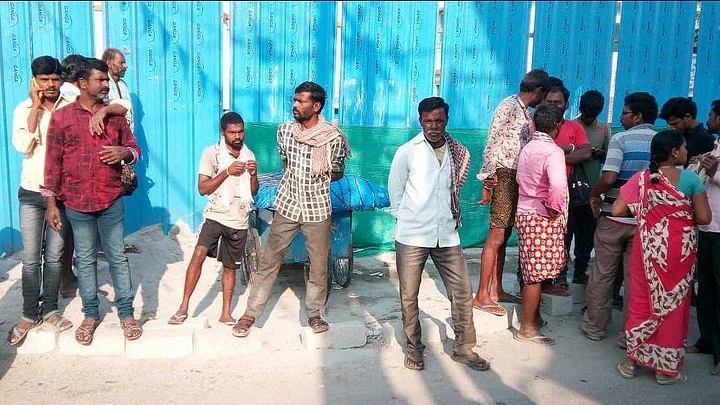Early findings from an ongoing livelihood survey conducted on nearly 4,000 workers in urban and rural areas since the middle of April to analyse the impact of the COVID-19 lockdown, has revealed that there has been a crippling effect on the vulnerable sections of the workforce, like the daily wagers and the migrant workers.
Workers were interviewed in Andhra Pradesh, Bihar, Delhi, Gujarat, Jharkhand, Karnataka, Madhya Pradesh, Maharashtra (Pune), Odisha, Rajasthan, Telangana, and West Bengal, and the survey was predicated on whether these people reported having jobs in February, the month preceding the lockdown.
As many as 67% of the 3,970 workers interviewed over phone calls, reported having lost their jobs.
Urban India appeared to have borne the greater brunt of the shutdown, with 8 in 10 workers in urban areas (80%) and almost 6 in 10 workers in rural areas (57%) reporting loss in source of income. More than four in ten salaried workers (43%) saw either a reduction in their salary or received no salary. Half (49%) of households reported that they did not have enough money to buy even a week’s worth of essential items.
The survey was conducted by researchers at the Centre for Sustainable Employment of the Azim Premji University in Bengaluru, along with multiple civil society organisations.
Of the households surveyed, 80% reported their income was less than Rs 10,000 per month, pre lockdown and are considered as ‘vulnerable’. 53% of the respondents surveyed were women.
Lockdown Impact More Severe in Urban Areas
As earlier mentioned, the findings of the survey were compared to the situation prevailing in February.
This is consistent with CMIE data noting that urban unemployment was higher for the week ending 3 May, as the COVID-19 lockdown had affected and led to creation of hotspots in cities. As many as 57% of workers interviewed in urban areas, reported receiving reduced or no salaries.
The self-employed in urban areas were the worst hit compared to the other categories as 84% lost livelihoods in urban areas, compared to casual wage workers and salaried professionals. In rural areas, all three types of workers saw job loss ranging from 47-66%.
Earnings Halved, Fell by 90%
For non-agricultural self-employed workers who were still employed, average weekly earnings fell from Rs 2,240 to Rs. 218 (a fall of 90%). Their earnings almost vanished through the course of the lockdown.
For casual workers who were still employed, average weekly earnings fell almost in half from Rs 940 in February to Rs 495 during the lockdown.
For regular salaried workers, nearly half reported no salaries or reduced salaries.
Over half of the farmers interviewed said that they were unable to harvest or sell their produce because of no workers or machines available, but a higher proportion – 52% –said that they lacked the transport to go to the market.
Surabhi Kesar, a researcher on the project said that while the findings were disturbing, they were not new vulnerabilities and only exposed pre-existing cracks in the framework.
“Self employed and casual wage workers have always been at the precipice and there is just falling through the cracks happening now. The lack of decent work and the amount of vulnerabilities is what we are seeing reflected in the crisis hitting the economy,” she said.
Impact on Households, Rent Payment and Expenses
While 8 out of 10 households reported that they were unable to pay rent, 37% of the households said that they had to take loans to meet their daily expenses. Of this, 42% reported having to take loans to meet expenses.
Informal loans emerged as the major source for families in need, mainly from money lenders, friends or others. The incidence of this was reported to be greater in urban areas.
When it came to food security, 37% rural households had money to cover a week’s worth of essentials, while in urban areas 66% of the families had enough money for a week’s expenses.
80% of urban households reported consuming less food than before while this figure was 70% in rural areas. About 86% of the urban households also reported saying that they would not be able to pay rent for the following month, while 54% of the households in the rural areas faced the same issue.
Extent of Relief Schemes Reach Like PDS, Jan Dhan
Through the findings, researchers found that public distribution schemes, out all of the government’s relief schemes, served as a lifeline for vulnerable households earning less than Rs 10,000 per month in February
In rural areas 89% respondents were able to get ration from a fair price shop, while figure was 69% in urban areas. People received an average of 5-7 kgs per person, per house.
Around 64% of the sample surveyed did not have Jan Dhan accounts. Of the 30% who did, they received some kind of transfer of money.
53% of rural households and 36% of urban households reported receiving some kind of cash transfer from the government. However, researchers noted that the extent of the relief measures were grossly inadequate for the crisis and recommending universalisation of the PDS, doubling of rations, and setting up of an urban employment guarantee programme, among other measures.
(At The Quint, we question everything. Play an active role in shaping our journalism by becoming a member today.)
